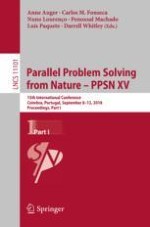This two-volume set LNCS 11101 and 11102 constitutes the refereed proceedings of the 15th International Conference on Parallel Problem Solving from Nature, PPSN 2018, held in Coimbra, Portugal, in September 2018.
The 79 revised full papers were carefully reviewed and selected from 205 submissions. The papers cover a wide range of topics in natural computing including evolutionary computation, artificial neural networks, artificial life, swarm intelligence, artificial immune systems, self-organizing systems, emergent behavior, molecular computing, evolutionary robotics, evolvable hardware, parallel implementations and applications to real-world problems. The papers are organized in the following topical sections: numerical optimization; combinatorial optimization; genetic programming; multi-objective optimization; parallel and distributed frameworks; runtime analysis and approximation results; fitness landscape modeling and analysis; algorithm configuration, selection, and benchmarking; machine learning and evolutionary algorithms; and applications. Also included are the descriptions of 23 tutorials and 6 workshops which took place in the framework of PPSN XV.
